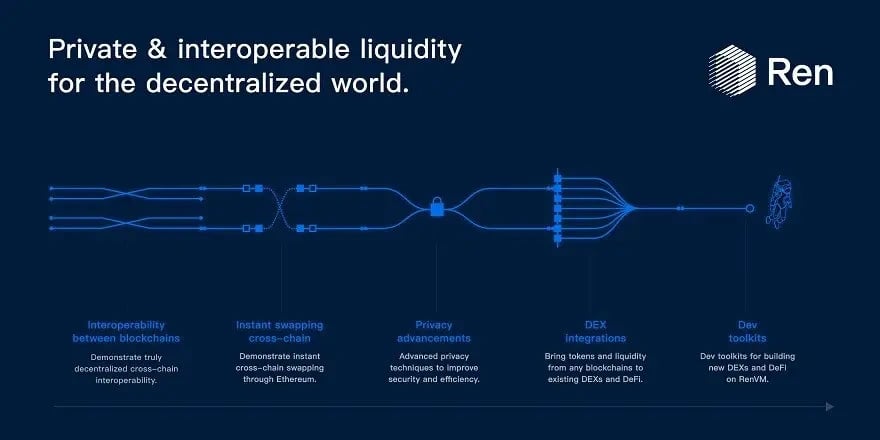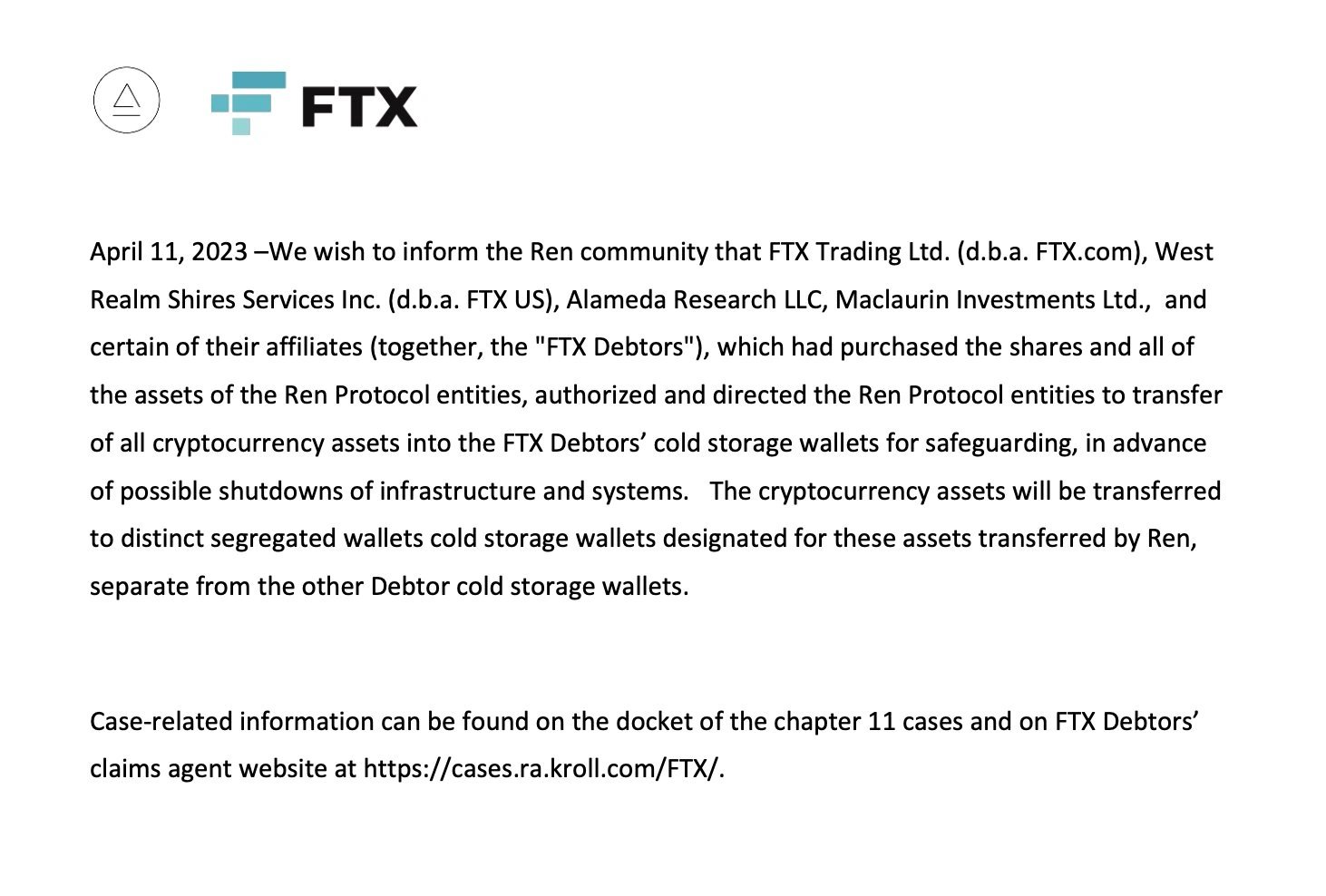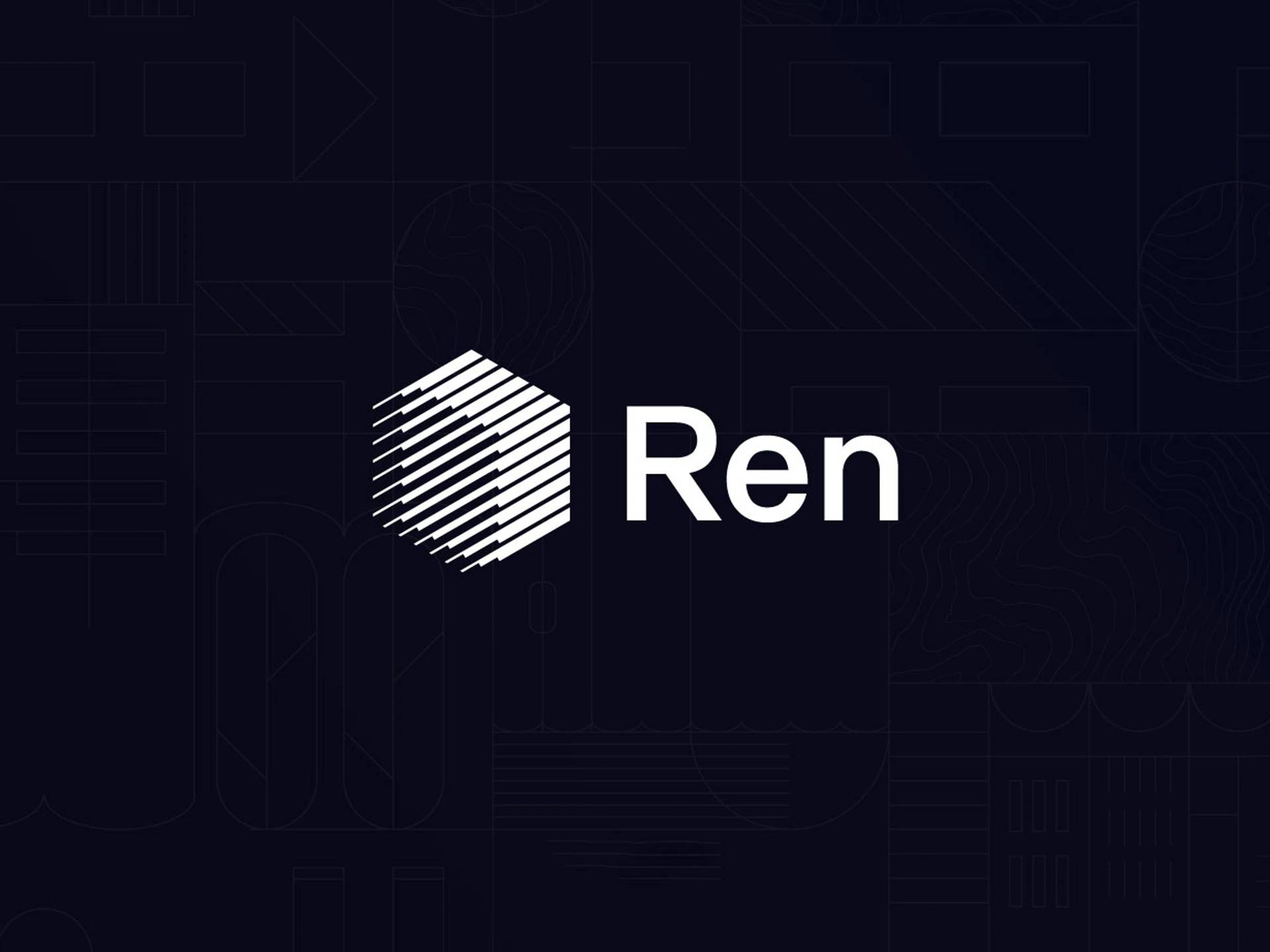위키 구독하기
Share wiki
Bookmark
Ren Protocol
Ren Protocol
Ren(이전 명칭: Republic Protocol)은 다양한 암호화폐 자산을 이더리움 블록체인으로 전송하는 것을 용이하게 하는 프로토콜로, 사용자는 자산을 매도할 필요 없이 탈중앙화 금융(DeFi) 상품에 접근할 수 있습니다. 다양한 블록체인에서 암호화폐 자산을 이동할 수 있는 기능을 통해 사용자는 스마트 계약에 자산을 잠그고 대신 ERC-20 토큰을 받을 수 있습니다. Ren의 자체 암호화폐인 REN은 Ren 네트워크의 운영 비용을 충당하는 데 사용됩니다. Ren의 주요 서비스인 RenVM은 안전한 다자간 컴퓨팅을 사용하여 서로 다른 블록체인 간의 상호 운용 가능하고 개인 정보가 보호되는 가치 전송을 가능하게 합니다. [1][2]
개요
Ren의 주요 기능은 디지털 자산이 서로 다른 블록체인 간에 이동하는 동안 보관자 역할을 하는 것입니다. 여기에는 자산을 안전하게 보호하고 대상 블록체인에 해당 토큰을 생성하는 작업이 포함됩니다. 예를 들어, 사용자가 BTC를 RenVM으로 전송하면 RenVM은 BTC를 보유하고 1:1 비율로 이더리움 블록체인에서 renBTC라는 ERC-20 토큰을 생성합니다. 이를 통해 renBTC의 가치는 항상 BTC의 가치와 같습니다. 이 프로세스는 도지코인 및 폴카닷 블록체인과 같은 네이티브 토큰을 포함한 거의 모든 디지털 자산 및 스마트 계약 시스템으로 확장할 수 있습니다. [3]

RenVM
RenVM은 안전한 다자간 컴퓨팅(sMPC)을 사용합니다. 이는 암호화 하위 분야로, 노드가 입력에 대한 함수를 공동으로 계산하면서 입력 개인 정보를 유지할 수 있도록 합니다. sMPC를 구현함으로써 RenVM은 입력이 노드를 포함한 모든 당사자에게 숨겨져 있도록 합니다. 이를 위해 RenVM은 각 노드 내에서 개인 키 조각을 분할하여 노드 자체가 어떤 조각을 소유하고 있는지 알 수 없도록 합니다. [5]
여러 블록체인에서 개인 키를 관리할 수 있는 기능을 통해 RenVM은 이러한 블록체인 간에 암호화폐를 전송할 수 있습니다. 노드 네트워크인 RenVM은 서로 다른 블록체인에서 ECDSA 개인 키를 안전하게 관리하는 자율 에이전트 역할을 하여 디지털 자산의 분산형 및 권한 없는 이동을 가능하게 합니다. 기술적으로 RenVM은 sMPC를 활용하여 ECDSA 임계값 키 생성 및 서명을 실행하는 비잔틴 장애 허용 프로토콜입니다. [5]
Ren 2.0
Ren 2.0은 Ren 위에 일반적인 애플리케이션 로직 지원, 더 넓은 범위의 서명 체계를 처리하고 확장성이 더 뛰어난 향상된 MPC 알고리즘, 그리고 생태계 참여자에게 인센티브를 제공하는 최적화된 토큰 경제학을 포함한 분산화 및 보안 강화에 중점을 둡니다. [4]
Ren은 Arbitrum, Polygon, Solana와 같은 스마트 계약 체인에서 광범위한 자산을 포함하도록 확장되었습니다. 이러한 멀티체인 지원은 암호화폐 공간에서 서로 다른 생태계 간의 상호 운용성을 용이하게 합니다. 또한 프로토콜에 두 가지 주요 업그레이드가 포함되었습니다. 첫째, 스마트 계약 체인 간의 renASSETS 직접 브리징이 가능해져 더 빠르고 비용 효율적인 전송 프로세스가 가능해졌습니다. 둘째, 이제 스테이블코인 및 ETH와 같은 네이티브 자산과 같은 일반 토큰을 이러한 스마트 계약 체인 간에 이동할 수 있습니다. [4]
Wrapped Bitcoin
2019년 1월, Ren은 Wrapped Bitcoin을 소개하는 백서 발표에 참여했습니다. 이 백서는 이더리움의 ERC-20 토큰 표준을 활용하는 "래핑된" 토큰의 개념을 소개했으며, WBTC가 출시될 첫 번째 래핑된 토큰이 될 것이라고 보장했습니다. [9]
WBTC는 이더리움 네트워크의 ERC-20 토큰으로 비트코인(BTC)의 대체재 역할을 합니다. WBTC는 이더리움 블록체인 생태계 내의 다른 ERC-20 토큰과 유사하게 작동합니다. 이를 통해 DeFi 프로토콜에서 사용하고 중앙화 거래소에서 거래할 수 있습니다. [9]
토큰 경제학
REN은 10억 개의 토큰으로 고정 공급 한도를 가진 암호화폐이며, 그중 60.2%는 2018년 사전 판매 및 공개 토큰 판매를 통해 투자자에게 판매되었습니다. Ren은 또한 총 공급량의 19.9%를 준비금으로 보유하고 있으며, 9.9%는 자문위원, 팀 및 설립자에게 할당되었으며, 팀 토큰은 2년, 자문위원 할당은 6개월의 락업 기간이 있습니다. 또한 REN 공급량의 10%는 파트너십 및 개발과 같은 활동에 할당됩니다. REN은 ERC-20 표준 토큰입니다. [3]
초기 코인 제공 (ICO)
2018년, Republic Protocol은 Republic 토큰(REN)에 대한 두 차례의 초기 코인 제공(ICO)을 시작했습니다. 첫 번째는 2018년 1월 말에 진행된 프라이빗 ICO로 2,800만 달러를 모금했습니다. 두 번째 ICO는 며칠 후 2월 초에 공개적으로 진행되어 480만 달러를 모금했습니다. [8]
설립자
Ren은 2017년 CEO인 Taiyang Zhang(장태양)과 Loong Wang(왕룽)에 의해 설립되었습니다. 원래 Republic Protocol로 알려진 Ren은 2018년 1월에 출시되었으며, Zhang은 주요 사용 사례를 "탈중앙화 다크풀"로 언급했습니다. Zhang은 또한 암호화폐 헤지펀드인 Virgil Capital을 공동 설립했습니다. [3]
그 이전에 Zhang은 2014년에 소프트웨어 및 웹 개발 스타트업인 Neucode를 공동 설립했습니다. Zhang과 함께 Neucode를 공동 설립한 Jaz Gulati는 Ren에서 소프트웨어 개발자로 근무하고 있습니다. [3]
Alameda Research
2022년 2월, Ren은 Alameda Research에 합류하여 자원을 확보하고 분산형 금융 산업에서 상호 운용성을 증진시키는 임무를 추진했습니다. Ren의 CEO인 Taiyang Zhang은 Alameda의 인수를 통해 기술의 분산화가 가속화될 것이며 회사는 Alameda의 자원으로부터 이익을 얻을 것이라고 말했습니다. [6]

잘못된 내용이 있나요?
